Union
minister of petroleum and natural gas Ram Naik told parliament on Wednesday
that there were limitations to supplying CNG as production from the Oil
and Natural Gas Corporation (ONGC) gas fields was declining. “Any
diversion of the committed supplies to the vital sectors like power and
fertiliser will affect them adversely,” he pointed out (Financial
Express, July 26, 2001).
“The real glitch is that there is simply not enough CNG to go around.
Did it occur to anyone to stock up on the fuel the minute the court issued
its orders? Of course not” (The Times of India, March 28, 2001).
Fact
MOPNG
is trying to project that an acute fuel crisis is about to hit public
transport. They have inflated demand projections of CNG much beyond the
estimates by Indraprastha Gas Limited (IGL) and argue that available gas
cannot meet this kind of demand.
This claim comes at a time when IGL fails to meet its commitment to set
up all the 80 CNG stations as mandated by the Supreme Court and falls
short of converting all the ‘daughter stations’ to ‘daughter-boosters’
to help keep uniform pressure for gas and reduce filling time.
MOPNG is silent on the fact that it is possible to increase allocation
for the transport sector. In the meantime more gas has been allocated
for affluent households in Delhi to substitute LPG that will not make
any impact on the air quality.
MOPNG has suddenly woken up to a new reality — that it has to ensure
long-term supply of CNG to the city. But it is also looking for an escape
route to avoid making such commitments. The ministry did not take the
Supreme Court orders of July 1998 to move the entire public transport
system to CNG, seriously. They had only considered buses but not the autos
and taxis which were also mandated to move to CNG. Surely 80 CNG stations
would not have been ordered by the Supreme Court if only buses had to
be catered to. (The real reason for the ministry’s slumber is, as
one senior official put it, “We did not expect the orders to be implemented.”)
The ministry has argued that it cannot supply the growing use of CNG by
vehicles. But there are several discrepancies in the CNG demand figures
given by the Ministry of Petroleum and Natural Gas (MOPNG) and the Indraprastha
Gas Ltd. (IGL). According to the Planning Commission, the ministry has
allocated 3.07 million standard cubic metre per day (MMSCMD ) that is,
24.76 lakh kg per day (one kg of CNG is equivalent to 1.24 standard cubic
metre) of natural gas for Delhi as follows:
Power: 2.60 MMSCMD (20.97 lakh kg
per day)
Delhi Vidyut Board (DVB): 0.84 MMSCMD (6.77 lakh kg
per day)
Pragati Power: 1.75 MMSCMD (14.11 lakh kg per day)
Others (which includes vehicles and households): 0.48 MMSCMD (3.87 lakh
kg per day)
According to the ministry, only an allocation of 0.15 MMSCMD (1.21 lakh
kg per day) has been made for vehicles. The rest has apparently been made
for households. It is now quite clear from the various estimates available
from the IGL and MOPNG that their demand projection has always remained
flawed and they are playing around with it to mislead everybody.
According to the submission of IGL on April 4, 2001 to EPCA,
While
the total demand of CNG from buses, autos and taxis in April 2001 was
1.00 lakh kg per day the supply capacity was 2.23 lakh kg per day38 (about
0.28 MMSCMD). In other words, according to this estimate, the current
demand then was only 51 per cent of the available dispensing capacity.
One bus consumes about 56.5 kg of CNG per day39. Therefore, if 10,000
buses were to run on CNG, the demand from buses only would be 5.65 lakh
kg per day (0.7 MMSCMD).
Supply by October 2001 would be 6.65 lakh kg per day (0.82 MMSCMD).40
Thus, there would be excess CNG available even after catering to all the
buses. Clearly availability of CNG as such was not a problem according
to IGL as on April 2001 (see table 8: Demand and supply).
Thus, demand and supply projections of IGL, made in April 2001, show that
the dispensing capacity will always remain ahead of the projected demand
till March 2002.
Around the same time, Ram Naik also pointed out that adequate quantity
of natural gas was available for the city. According to his estimates
presented to the media in the first week of April, there was supply of
1.96 lakh kg per day of CNG as against a demand of 0.95 lakh kg per day.
Thus, according to his estimates, the present capacity utilisation was
only of about 48.5 per cent.41
But
a new game unfolded in the month of July, 2001, when the former managing
director Rajiv Sharma was dismissed and with the change of guard the estimates
for demand
and supply also changed overnight.
Demand and supply projections of IGL, made in April 2001, show that the dispensing capacity will always remain ahead of the projected demand

In
its presentation to EPCA in July 2001, IGL revised its older estimates.
In the new estimates, they modified the consumption figures for all vehicles.
While according to the old estimates given in April a bus consumed 56.5
kg of CNG per day, the new estimate is that of 70 kg per day. The new
daily consumption estimate for cars and taxis was doubled from 4kg to
8 kg and that of three-wheelers from 3 kg to 5 kg.42
The consequence is that the July estimate shows that the dispensing capacity
will catch up with demand only in September 2001 once, slide back again
and then catch up once more in February, 2002 (see graph 8: CNG demand
and dispensing capacity of IGL).
What is the petroleum and natural gas ministry doing about this?
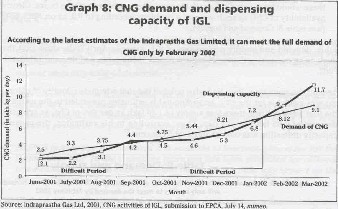
MOPNG
is trying to cash in on the existing shortfall to create a sense of an
acute fuel crisis to hit public transport in Delhi.
MOPNG has tried to inflate the demand projection of CNG much beyond the
IGL estimate. The ministry projects that CNG demand in Delhi will increase
to almost 16 lakh kg per day by June 2002 against the present allocation
of 1.2 lakh kg per day (see table 9: Inflated). This is an increase of
over 13 times. However, if the latest consumption figures as given by
IGL are used for the number of vehicles used by MOPNG, the demand goes
up to 21.5 lakh kg per day (see table 10: Difference of opinion). IGL
now estimates that CNG demand will go up by almost 12 times by March 2002,
but the difference between IGL and the ministry’s projection for
the per day consumption in 2002 is still in the region of more than 5
lakh kg of gas. The ministry has played around with the number of vehicles
very liberally to project very high demand for gas.
The ministry’s estimates are based on a number of erroneous assumptions
(see table 10: Difference of opinion). Even when three-wheelers (these
are the only light public transport vehicles run on petrol because taxis
run on diesel) were allowed to run on petrol their total registered number
in January 1999 was about 87,000.44 If the fact that no commercial vehicle
more than 15 years old are allowed to operate in Delhi is taken into account,
it would bring their number down to about 57,000. Even IGL’s estimate

puts
the number of three-wheelers at around 50,000 in March 2002.45 Therefore,
the estimate of the ministry is a gross overestimate for autos, almost
three times higher than the actual numbers.
The number of cars on CNG, according to the ministry, would be 70,000
in June 2002.46 This again is a clear case of exaggeration. IGL estimates
that the number of cars and taxis put together would be around 37,400
in March 2002.47 Thus, the ministry’s estimate is almost double of
the actual numbers. The number of registered taxis
in 1998 was 1.66 million. After getting rid of more than 15 years old
it cannot still exceed maximum 10,000. There is no reason for such dramatic
increase in the number of private CNG cars.
MOPNG has projected the demand so high to argue that investment to meet
such high level of demand will be quite prohibitive as this would need
major improvements in the system, including upgradation of the existing
pipeline system from Hazira to Dadri and Delhi (with a length of about
1,145 km), which will involve a huge cost.48
IGL fails to keep its commitments: Supply of CNG fails to keep pace with
demand
The long queues for CNG and harrowing experience of the CNG users are
legend. IGL has failed to speed up its dispensing capacity and supply
to meet the sudden surge in demand for CNG despite its commitments to
the EPCA. Once the Supreme Court made it clear that it would not entertain
any dilution of its original order, the CNG market that was sluggish initially,
picked up and within a very short time a large number of vehicles in different
segments rolled in (see table 11: High on gas). IGL was caught unawares.
People are only busy counting the numbers of stations. Even though as
many as 74 stations as against the original mandate of 80 stations are
in place it is the inadequate dispensing capacity and low pressure levels
in each of these stations that have compounded the problem.
Latest projections of demand and supply from IGL show that supply will
fall short of demand till the end of 2001 and long queues can be expected
till then.
Just in three months IGL has backtracked on many of its earlier commitments
to EPCA (see table 12: Yawning gap). In May 2000, IGL had assured that
compressors needed to convert all daughter stations to daughter-booster
stations (in order to provide speedy dispensing of CNG) were already on
their way from Argentina. But these are still not in place.39 Because
of these delays there are long queues of cars, autos and buses waiting
to get CNG.
Investments
delayed
It
is obvious that IGL has not made timely investments. IGL had plans to
spend Rs 328 crore in the first phase but has spent only Rs 123 crore
of that till now.50 Only now when the court order is on its head is IGL
thinking of taking a loan of Rs 200 crore from the Oil Industry Development
Board. Converting daughter stations to daughter booster stations is the
need of the day to increase dispensing capacity. But it is clear that
orders for compressors were obviously not placed in time and thus from
April 2001 to July 2001 only five daughter stations could be converted
to daughter booster stations.
In the meantime the queues for CNG are getting longer and rarely do consumers
get a tankful of CNG. Why is this so? There are several issues related
to the supply of CNG:
a) Speedy supply at dispensing stations,
b) Long-term assurance supply of CNG, and
c) Reliability of CNG supply
Number
of dispensing stations
A researcher
of CSE who visited Mumbai in April 2001, found that while Mumbai was dispensing
one lakh kg of CNG per day through 22 stations,51 Delhi supplied 0.95
lakh kg of CNG per day through 68 stations,52 that is, over three times
the number of dispensing
stations than Mumbai. However, by June 2001, the daily sales in Delhi
went up to 1.92 lakh kg per day.
Mumbai also has long queues but this is mainly because of a large number
of vehicles, not the long time taken in dispensing CNG. In Mumbai, Mahanagar
Gas Ltd has to set up more dispensing stations but there is a serious
problem of land availability and there is not enough space in existing
petrol pumps because of safety requirements for CNG dispensing stations.
So why does Delhi with so many dispensing stations have long queues? Several
factors are responsible for this.

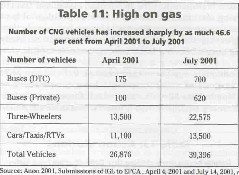
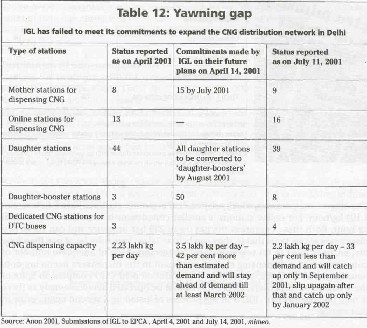
MOPNG’s projection of demand for CNG in Delhi is based on wrong assumptions and is almost double the estimate of IGL.
Latest
projections of demand and supply from IGL show that supply will fall short
of demand till the end of 2001 and long queues can be expected till then.
One factor is the lack of an adequate number of compressors.
In Delhi, out of 74 stations, 47 are daughter stations of which only eight
have compressors or boosters.34 In comparison, Mumbai has 22 stations,
of which there are only four daughter stations, all of which are equipped
with boosters (see table 13: Action stations).55
The biggest compressors, which are installed in mother stations, have
a flow rate of 1,100 kg/hour. For online stations, a smaller compressor
is used which can fill 250 kg/hour. Both these compress the gas up to
250 bar pressure and can serve two dispensers at one time, that is, they
can help to fill up four vehicles at one time (one dispenser is used to
fill two vehicles).56 Therefore, lack of adequate number of compressors
in a dispensing station can result in the dispensers becoming non-functional.
For instance, at the dispensing station near CGO complex, in spite of
there being five dispensers, all of them cannot be operated simultaneously
as there is only one compressor. IGL is in the process of installing a
second compressor in that station.57
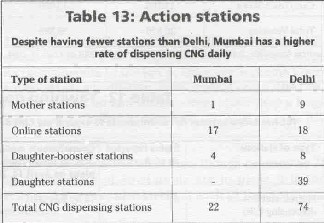
There is another type of compressor called booster, which is used
only in daughter stations. The booster is used to increase the pressure
of the gas when the pressure in a cascade drops to about 180 bar from
the required filling pressure of 200-220 bar while dispensing gas. In
absence of a booster, it is not possible to dispense gas once the pressure
level falls to 180 bar, and then the cascade has to be changed.58 Cascades
full of CNG under adequate pressure are brought to a daughter station
after being filled at a mother station. A mother station is connected
to the pipeline.
A study on filling time of three-wheelers done by IGL in daughter stations
without boosters in Delhi showed that when the filling pressure is 200
bar, it can fill the cylinder of a three-wheeler to its full capacity,
that is, 3.5 kg in 90 seconds. But when the pressure drops to 180 bar
in the cascade, it can fill up to only 3.15 kg. It takes 67 seconds to
do so. At a pressure of 165 bar, the cylinder can be filled up to 2.89
kg only in 48 seconds, and at 150 bar only 2.63 kg can be filled up and
it takes 29 seconds to do so. At this pressure, it is not possible to
fill the cylinder any more and the cascade needs to be changed and replaced
with a new one.59 In other words, once the pressure drops in the cascade
of a daughter station, very little gas gets filled up in the vehicle’s
cylinder. This means that a commercial vehicle which runs all the day
has to keep coming back to a refilling station.
Number of cascades in a dispensing unit
This points out to another problem in the dispensing of CNG in
Delhi, that is, inadequate number of cascades in a daughter station. If
there are an inadequate number of cascades, then the dispensing station
will have to be closed till more cascades are obtained. While the daughter
stations in Mumbai have 3-6 cascades on average, in Delhi, there are less
than three cascades for each daughter station. There are 47 daughter stations
in Delhi and about 120-125 cascades. At a given point of time one cascade
is used, one is getting filled up at the mother station and one is in
transit. Not surprisingly daughter stations often have no gas to dispense
in Delhi.60
Distribution of dispensing stations
Besides the problems with the dispensing stations, the distribution
of dispensing stations is also a problem. There are 31 stations in south
Delhi in comparison to 12 in north Delhi and 11 in central Delhi. East
and west Delhi have only nine stations each. While all the mother and
online stations are restricted to north and south Delhi, east Delhi has
only daughter stations and that too without boosters. All the nine stations
in west Delhi are daughter stations but only two with a booster.61 This
means that IGL must move fast to extend the pipeline to east and west
Delhi (see table 14: Weak links).
According to MOPNG, though there are 74 CNG stations in Delhi but only
16 online stations are catering to 75 per cent of the demand and that
is resulting in long queues.44 If this is true, it is obvious that this
is happening because better pressure is maintained at the online stations.62
Gas
allocation
MOPNG argues that production and supply of natural gas from the
ONGC wells are declining on account of the fact that these wells are more
than 15 years old. In this scenario, increasing the allocation of more
CNG to Delhi would mean decreasing the allocation of natural gas to industries,
power stations and fertiliser units which are being fed from the existing
gas pipeline. “This would have a serious impact on the economy of
the country” says the ministry.68 But the ministry is not concerned
about improving public health.
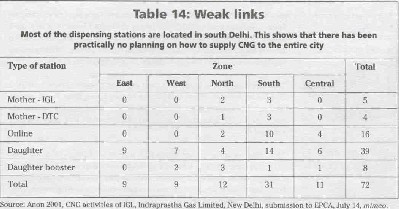
The ministry, therefore, does not want autos, taxis and cars to
get converted to CNG. Instead it wants them to continue to run on the
petrol (unleaded petrol with 1 per cent benzene) and diesel (with 500
ppm sulphur content) which are now available in Delhi. The ministry is
only prepared to assure gas supply for 12,000 buses. But this is only
the current busload in the city. The city is scheduled to grow from its
current population of 14 million to more than 22 million in 2021.69 How
will the gas needs of the future bus requirements be met? It is obvious
that the current allocation strategy has to change to take into account
public health.
The key issue here is prioritising allocation of natural gas. There is
much scope of allocating more natural gas to Delhi but MOPNG is not willing
to do that. Instead it is trying to raise the bogey of gas shortage.
Even as the transport sector is being starved of gas, piped gas is being
supplied to hotels and affluent households. It was first supplied to Kaka
Nagar, Bapa Nagar and Pandara Park in 1997 as a pilot project. Since then
it has been extended to Golf Links, Sunder Nagar and Sujan Singh Park.
More recently, gas supply has started in Nizamuddin (east and west), New
Friends Colony, Friends Colony, Maharani Bagh, Kalindi Colony, Sukhdev
Vihar, Sukhdev Vihar Pocket A & B, Ishwar Nagar and Zakir Bagh. In
addition, five-star hotels The Hyatt Regency, Hotel Taj Mahal, Hotel Oberoi,
Hotel Ambassador and Hotel Surya have switched over to natural gas for
commercial application like cooking, water heating, air conditioning,
space heating, and power generation.70
All these areas are high income areas which were earlier using LPG. Switching
from LPG to CNG will have almost no impact on pollution reduction. In
any case, there is no shortage of gas, it is a question of allocating
enough gas to meet the vehicular demand of Delhi.
Gas allocations are made by MOPNG on the recommendations of the Gas Linkage
Committee (GLC), which is an inter-ministerial committee with representatives
from the planning commission, and the Union ministries of finance, power,
chemicals and fertilisers and steel. The allocations are made based on
the requests received, taking into consideration the existing allocations
and the gas availability projections in different regions from time to
time.
In view of the importance of the fertiliser and power sectors in the national
economy, preference in allocations has been given to these sectors. As
and when shortage of gas is perceived in any region, an action plan for
the region is drawn up and approved by the GLC wherein fertiliser and
the power sectors are given priority. The departments of fertiliser and
power are consulted in this regard and the GLC, while approving the action
plan considers the bulk allocation for each of these sectors while leaving
the individual requirements of each unit to these departments within the
overall allocation for the sector. All gas-based units are required to
have dual fuel capability so as to use other fuels whenever availability
of gas is restricted.
The Planning Commission has set up a working group on petroleum and natural
gas for the Tenth Plan under the chairmanship of the secretary, MOPNG.
The working group has set up various subgroups including a subgroup on
demand of petroleum products and a subgroup on natural gas production,
availability and utilisation. The working group coordinates the functioning
of the various subgroups. This practice was also followed for the Ninth
Plan.
At present the gas allocation for consumers in Delhi is 3.07 MMSCMD (24.76
lakh kg per day) — 2.59 for power and 0.48 for other consumers. Out
of 0.48 MMSCMD (3.87 lakh kg per day) only 0.15 has been allocated for
transport and the remaining 0.33 MMSCMD (2.66 lakh kg per day) for households.
Though there is a proposal from IGL requesting GLC to allocate an additional
1 MMSCMD (8.06 lakh kg per day) of gas to Delhi, MOPNG has shown no intent
to approve the proposal.
IGL claims that the all their CNG stations are over-utilised and are working
at more than 100 per cent of their capacity. Gas dispensation capacity
is estimated on the basis of the 18 hours of operation per day. But as
of now they are operating their stations for almost 24 hours. But even
with this kind of utilisation, IGL is not able to meet the demand for
transport in July 2001. IGL’s dispensing capacity in July, 2001,
is 0.27 MMSCMD (2.22 lakh kg per day).
According to IGL, out of an allocation of 0.48 MMSCMD (3.87 lakh kg per
day) only 0.15 (1.21 lakh kg per day) MMSCMD has been allocated to the
transport sector. This means that IGL is already diverting 0.12 MMSCMD
(0.96 lakh kg per day) from the allocated gas to the domestic sector.
IGL can play around with supply as long as it is within 0.48 MMSCMD (3.87
lakh kg per day), according to its new managing director, A K Dey . Going
by IGL’s estimates, in September 2001, the total demand by the transport
sector will be 0.52 MMSCMD (4.2 lakh per day) and dispensing capacity
will remain around 0.54 MMSCMD (4.4 lakh kg per day). Both overshoot the
total allocation of 0.48 MMSCMD. Therefore, at least 0.06 MMSCMD (0.48
lakh kg per day) will have to be allocated from other sectors for Delhi
by September 2001.
According to MOPNG, Delhi will need a maximum of 2 MMSCMD of CNG (16.13
lakh kg per day) in June 2002. This means a further allocation of 1.52
MMSCMD of natural gas to the city is required. According to IGL’s
corrected estimates Delhi’s transport will need only about 1.4 MMSCMD
(11.33 lakh kg per day) by March 2002. This is just 4.1 per cent of the
capacity of the Hazira-Bijaipur-Jagdishpur (HBJ) pipeline with a capacity
of 33.4 MMSCMD (269.4 lakh kg per day). Even MOPNG’s inflated estimate
amounts to just 4.6 per cent of the capacity of HBJ pipeline. Thus there
is no reason why this demand cannot be met.
Intervention by the Supreme Court to increase gas allocation
The
Supreme Court has in the past intervened in the allocation of gas. The
allocation of gas for Mathura Refinery was made as per the directives
of the Supreme Court to supply clean fuel, that is, natural gas, to all
polluting industries in the Taj Trapezium Zone in order to save the ecology
and environment around the Taj Mahal. The polluting industries included
the Mathura Refinery and accordingly gas allocation of 1.4 MMSCMD (11.29
lakh kg per day) was made by the GLC to the Mathura Refinery. The pipeline
was laid and supply commenced in 1996.
There are precedents to show that gas allocation have been augmented to
meet higher demand from other sectors as well. Here are some instances:
In September 2000, allocation to Essar Oil Ltd was
increased by 0.7 MMSCMD (5.65 lakh kg per day) from 1.71 to 2.41 MMSCMD.
that is, an increase of 5.64 lakh kg per day. Similarly, Reliance Refineries
Limited got an increased allocation of 0.4 MMSCMD (3.22 lakh kg per day)
raising it from 0.49 to 0.89 MMSCMD.
In 1999, a new allocation of 0.85 MMSCMD (6.8 lakh
kg per day)was made to Indian Petrochemicals Corporation Limited (IPCL),
Dahej.
In July 1999, National Thermal Power Corporation (NTPC),
Kawas was allocated 2.1 MMSCMD (16.94 lakh kg per day). NTPC was further
allowed NTPC to divert 1.5 MMSCMD(12.09 lakh kg per day) of the allocated
gas to their plant at Jhannore in 2001.
Allocation of 1.75 MMSCMD (14.11 lakh kg per day) of
gas was shifted from the proposed power plant at Bawana that did not come
up, to the proposed Pragati power plant of DVB in 2001. But Pragati power
plant is yet to see the light of the day.
Around 0.4 MMSCMD (3.22 lakh kg per day) of gas was
allocated to Gujarat Industries Power Corporation Limited (GIPCO), Vadodara,
by GAIL without any firm allocation.
Gujarat State Fertiliser Corporation (GSFC), Vadodara,
was supplied 0.8 MMSCMD (6.45 lakh kg per day) of gas to by GAIL against
an allocation of only 0.4 MMSCMD (3.22 lakh kg per day) by GLC.
DVB was given was given 1.2 MMSCMD (9.68 lakh kg per
day) of additional gas by GAIL against an allocation of 0.84 MMSCMD (6.77
lakh kg per day) by GLC.
GAIL supplied around 1.46 MMSCMD (11.77 lakh kg per
day) to different consumers against an allocation of 0.48 MMSCMD (3.87
lakh kg per day) by sanctioned by GLC.
The central minister of state for petroleum has written
a note to GAIL asking it to work for city gas distribution in the city
of Lucknow (the prime minister’s constituency) and Bareilly (constituency
of minister of state for petroleum). On the basis of this MOPNG has approved
a total allocation of 0.15 MMSCMD (1.20 lakh kg per day), of which allocation
for Lucknow is 0.1 MMSCMD (0.80 lakh kg per day) and 0.05 MMSCMD (0.40
lakh kg per day) for Bareilly.
All this extra allocation has been done after the Supreme Court orders
of July 28, 1998.
How can gas dry up if there are major expansion plans for gas supply in
the future?
The expanded infrastructure being planned for delivery of regasified LNG
to northern India is the expansion of the HBJ pipeline network from a
capacity of 33.4 MMSCMD (269.35 lakh kg per day) to over 60 MMSCMD (483.87
lakh kg per day). The first phase envisages 800 km pipeline network linking
Dahej LNG terminal with the HBJ system at Vemar in Gujarat and a parallel
42 inch pipeline to the existing HBJ pipeline from Vemar upto Vijaipur
to transport 30 MMSCMD (241.94 lakh kg per day) of additional gas to the
states of northern India. The investment in the first phase would be approximately
Rs. 2,968 crore. The second phase envisages additional compression facility
and expansion of the existing HBJ pipeline to Delhi and beyond to Haryana
and Punjab to meet the requirements of natural gas in these states. The
details of investment plans in the second phase are being worked out.
How can gas become scarce with such massive projects in advanced stages
of planning?